
Sintra is a town and municipality in the Greater Lisbon region of Portugal, located on the Portuguese Riviera. The population of the municipality in 2021 was 385,654, in an area of 319.23 square kilometres (123.26 sq mi). Sintra is one of the most urbanized and densely populated municipalities of Portugal. A major tourist destination famed for its picturesqueness, the municipality has several historic palaces, castles, scenic beaches, parks and gardens.

The Palace of the Dukes of Braganza is a medieval estate and former residence of the first Dukes of Braganza, located in the historical centre of Guimarães, in the north-western part of Portugal.

Cascais is a town and municipality in the Lisbon District of Portugal, located on the Portuguese Riviera. The municipality has a total of 214,158 inhabitants in an area of 97.40 km2. Cascais is an important tourist destination. Its marina hosts events such as the America's Cup and the town of Estoril, part of the Cascais municipality, hosts conferences such as the Horasis Global Meeting.
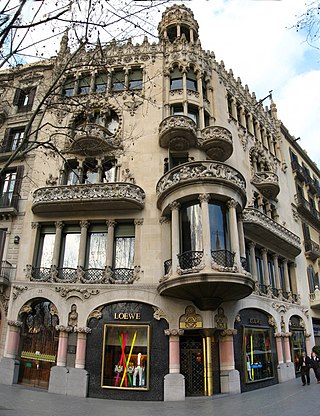
The Casa Lleó Morera is a building designed by noted modernisme architect Lluís Domènech i Montaner, located at Passeig de Gràcia 35 in the Eixample district of Barcelona. In 1902 Francesca Morera assigned Lluís Domènech i Montaner to remodel ancient "casa Rocamora", built in 1864. She died in 1904, and the building was named after her son, Albert Lleó i Morera. The building is located on the corner of Carrer del Consell de Cent, and is one of the three important buildings of Barcelona's Illa de la Discòrdia, and it is the only building of the block awarded Barcelona's town council's Arts Building Annual Award, obtained in 1906. The building lost some of its most representative elements, such as the tempietto on its top and the ground floor and mezzanine's architectural sculpture. The building is also known as the residence of Cuban-Catalan photographer Pau Audouard.

The Fort of São Sebastião de Caparica also known as the Tower of São Sebastião or Fortress of the Old Tower is a medieval fortification located in Monte da Caparica, civil parish of Caparica, in the municipality of Almada, in the Portuguese central region of Península de Setúbal.

The Casa dos Bicos is a historical house in the civil parish of Santa Maria Maior, in the Portuguese municipality of Lisbon. The house, built in the early 16th century in the Alfama neighbourhood, has a curious façade of spikes, influenced by Italian Renaissance palaces and Portuguese Manueline styles. It survived the disastrous 1755 Lisbon earthquake that destroyed much of the city, but over time was abandoned as a residence and used as a warehouse. After a 20th-century renovation, it became the headquarters of the José Saramago Foundation and a location of the Museum of Lisbon.

Residencia Armstrong-Poventud is a historic building located in the Ponce Historic Zone in Ponce, Puerto Rico, across from the Catedral Nuestra Señora de Guadalupe. The construction of this home set the stage for the construction of other homes of similar architectural elements, character and opulence in turn-of-the-twentieth-century Ponce. The architectural style is collectively known as Ponce Creole. The home was designed and built by Manuel Víctor Domenech for the Armstrong-Poventud family. It is listed on the U.S. National Register of Historic Places as the Armstrong-Toro House, and is also known as the Casa de las Cariatides. In 1991, the Instituto de Cultura Puertorriqueña turned the house into a museum, which it manages.
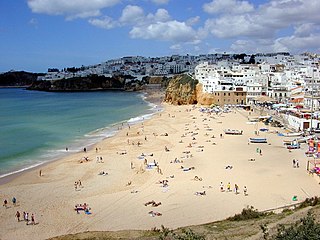
Albufeira is a city and municipality of Faro District in the Algarve region of southern Portugal. The population in 2021 was 44,158, in an area of 140.66 square kilometres. The city proper had a population of 28,645 in 2021. It is 250 kilometres (160 mi) from Lisbon, close to Paderne Castle. Lagoa is 30 kilometres (19 mi) to the west, and Faro 45 kilometres (28 mi) to the southeast. A tourist destination due to its coastal conditions, Albufeira's population expands to around 300,000 in the summer and at Christmas and New Year owing to the number of hotels that includes marina facilities, golf courses, restaurants and bars.
The Castle of Barbacena is a former-medieval castle/fort in the civil parish of Barbacena e Vila Fernando, municipality of Elvas in the Portuguese Alentejo, classified as a Property of Public Interest.
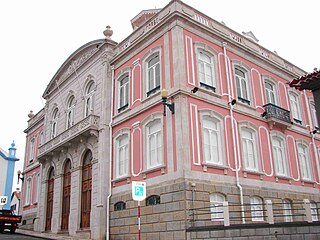
The Residence Silveira e Paulo is located on Rua da Conceição, in the civil parish of Nossa Senhora da Conceição, in the historic centre of Angra do Heroísmo, Terceira Island, in the Portuguese archipelago of the Azores. Completed in the style of the late 19th century, the residence is one of the more notable examples of Azorean civil construction in the transition between 19th and 20th centuries.
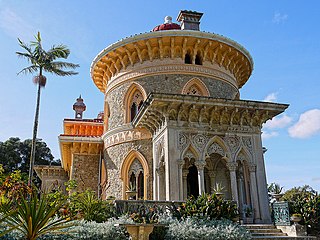
The Portuguese Riviera is a term used in the tourist industry for the affluent coastal region to the west of Lisbon, Portugal, centered on the coastal municipalities of Cascais, Oeiras and Sintra. It is coterminous with the Estoril Coast and occasionally known as the Costa do Sol. Portuguese themselves do not use this expression.

The Casa de Santa Maria was once a luxurious private residence in Cascais, Lisbon District, Portugal. It was acquired by the Cascais Municipality in October 2004 and is now a museum. It blends several different architectural styles and influences.
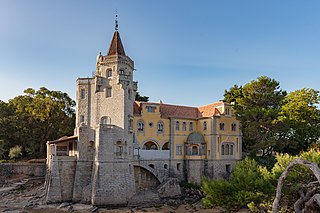
The Palácio dos Condes de Castro Guimarães, originally known as the Torre de São Sebastião, was built in 1900 as an aristocrat’s summer residence in Cascais, Lisbon District, Portugal. It became a museum in 1931. The building follows an eclectic architectural style, while the museum includes paintings of national and international significance, furniture, porcelain, jewellery and a neo-Gothic organ.

The Museum of Portuguese Music is a small museum housed in the Casa Verdades de Faria in Estoril, municipality of Cascais, Portugal, on the Portuguese Riviera. It contains a collection of Portuguese musical instruments and other items, as well as a music documentation centre, and is also used for recitals.

The King D. Carlos Sea Museum is a Maritime Museum in the fishing town of Cascais, Lisbon District, in Portugal. It was inaugurated in 1992.

The Palácio dos Condes da Guarda is located in Cascais, Lisbon District, Portugal. The building now functions both as the headquarters of the Municipality of Cascais and, on the ground floor, as a museum that explains the history of the town.

The Palmela Palace, also known as the Conceição Velha, was a summer residence in Cascais, Lisbon District, Portugal built for the Duke and Duchess of Palmela in 1874. It is considered to be a major example of the so-called summer architecture of the Cascais area.

Summer architecture was a Portuguese architectural movement originating in the Portuguese Riviera, in late 19th and early 20th century, when the region became a popular resort destination for the Portuguese royal family and the Portuguese aristocracy. The movement is not characterized by any single architectural style or artistic school, but rather unified by common themes, including leisure, wellness, exoticism, and heterotopia.

The Sporting Club of Cascais was an elite sports and recreational society in Cascais in the Lisbon District of Portugal.

The Solar da Marquesa de Santos is a manor house located in central São Paulo, Brazil, that hosts several cultural exhibitions and is currently the headquarters of the Cidade de São Paulo museum.



















